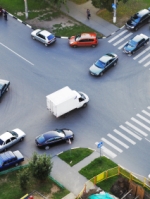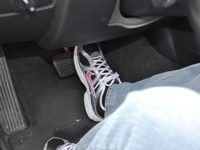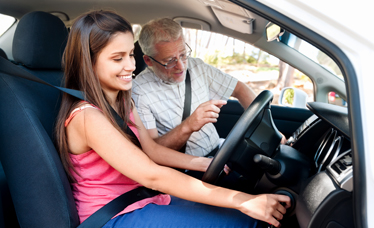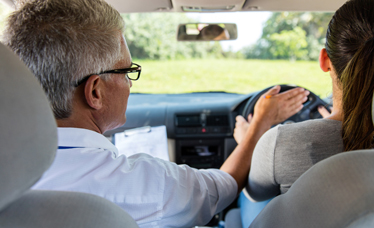Chapter 5 – Section 1
Defensive Driving Techniques
Collision prevention involves many factors. The key is to drive defensively. Below are some ways to avoid getting into a traffic crash.
-
A. Scanning the Road
-

Scanning the road at intersections keeps you aware and prepared for oncoming hazards.
When you drive, scan the road and keep your eyes moving, never focusing on just one point. Scanning the road ahead, particularly on the highway and in dangerous driving situations such as at intersections, bottlenecks, and broken traffic signals, keeps you aware and prepared for oncoming hazards. When approaching a hill or curve, scanning ahead allows you to see posted speed limits or observe the speed of the vehicles you are following so you can adjust your speed appropriately. To help you scan for danger effectively, use the SIPDE technique as described below:
-
1. Scan (or Search)
-
First, scan the road for traffic conditions and possible hazards. To scan effectively, you need to check as much of the road as possible by looking ahead at least 15 seconds, not just right in front of you. In the city, this means looking at least one to two blocks (about a quarter mile) ahead; when driving on the highway, you should be checking at least one-third to half a mile in front of you. Also scan left to right and check your mirrors to see behind your vehicle. Keep your eyes moving so you can see a dangerous situation before it affects affect you. This technique is also very helpful on rural roads and at intersections where unexpected hazards may occur.
-
2. Identify
-
The next step in this process is to identify any hazards ahead. Is a deer about to cross the road in front of you? Has a large branch broken off a nearby tree and fallen onto the roadway? Is a crash blocking a lane on your side of the road? If you know what the hazard is, you can respond to it appropriately.
-
3. Predict
-
Once you identify the hazard, you need to predict the possible outcomes and how they may affect your safety. If a deer is crossing the road, it may either linger on the pavement or be followed by other deer, blocking your path. If a tree branch has fallen on the road, you may have to change lanes, pull over to the shoulder, or stop altogether. If you see a crash scene ahead, you need to slow down or move to a safer lane. After identifying a hazard, you need to be able to predict all possible consequences. The media often uses opinion polls to predict the outcome of elections.
-
4. Decide
-
Next, you must decide on a sensible course of action to avoid the hazard with time to spare. Choose the safest option. Look for escape routes if you think you may have to change your position on the road. If that is not possible,be prepared to slow down or stop. If there are other people or vehicles on the road, you may also have to turn on your hazard lights, signal or use the horn to warn them of the danger ahead.
-
5. Execute
-
Last, execute the course of action you chose.For example, if you decided that changing lanes is the safest option, simply do what you decided on so you can avoid the hazard.
To use SIPDE effectively, you must be an active defensive driver who can anticipate outcomes and make quick decisions. This means you must pay attention to your surroundings and notice any hazards before you reach them. If you allow yourself to be distracted, you are at risk because you are not able to scan the road effectively.
The animation below reviews how to properly use the SIPDE method, using a rock slide as an example.
-
-
B. Using Your Turn Signal
-
If you plan to change course, such as make a turn or change lanes, communicate your intention to others on the road by using your turn signal. Keep your signal on continuously during the last 200 feet traveled before a turn or other maneuver. If you are driving on a road with a speed limit of 50 mph or higher, you must signal 300 feet before you turn or change lanes.
-
C. Backing Up
-
The law states that you may back up a vehicle only if you can do so with reasonable safety and it does not interfere with other vehicles.[1] It is unwise and unsafe to back up around corners or curves in the road. When backing up, follow these guidelines:
- Be aware of pedestrians, especially children, as well as and objects on the road behind you.
- Back up only when you have to
- Be cautious while backing up and turn your head and body to face the direction in which you are moving.
- Release the brake pedal only when you are prepared to back up and your view is to the rear.
- Use your side mirrors as much as necessary.
- Keep backing speed at a slow and controlled level.
- Avoid sharp turns and be aware of odd angles that may result from backing up.
- Use passengers to lend assistance.
-
D. Covering the Brake
-

Covering the brake is a safe driving practice.
Covering the brake means placing your foot over the brake pedal without touching it so you can access it quickly if necessary.It is a good idea to cover the brake when you may need to apply the brakes quickly. Many video games require the ability to react quickly. Covering the brake is recommended when:
- Driving next to parked cars.
- Approaching intersections.
- Approaching signals.
- Driving in a school zone.
- Seeing the brake lights of other cars.
Riding the brake (keeping your foot slightly pressed down on the brake pedal) wears out your brakes. It also gives other drivers the false impression that a stop is imminent. In contrast, covering the brake is often prudent and a safe driving practice.
1 New Jersey Statute 39:4-127















